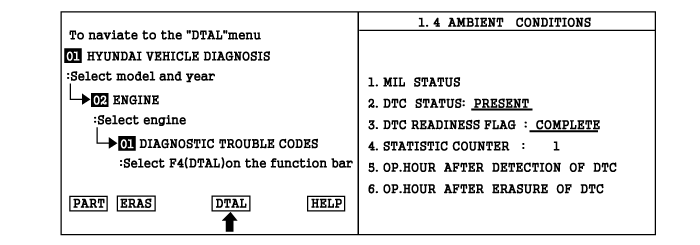Read "DTC Status" parameter

The CVVT (Continuously Variable Valve Timing) system is installed to the chain sprocket of the exhaust camshaft. There is no variation in valve timing of the exhaust cam because the exhaust camshaft is driven by the timing belt. The timing of the intake cam is varied by the relative operation the CVVT vane to the housing. This system helps the engine decrease exhaust gases and increase engine power and fuel economy by changing the valve open / close timing of the intake camshaft.
This diagnosis checks the camshaft position plausibility whether the expected range plus some margin is not violated that might be caused by a wrong engine repair, or a chain/belt misalignment. DTC P0016 is set when actual camshaft position is too much retarded or advanced than full retard position or full advance position. To continue the adjustment in such case could lead to a damage of the engine by hitting the valves with the piston.
Item | Detecting Condition | Possible Cause |
DTC Strategy | ● Monitor Camshaft position in the full retard condition or during CVVT control | ● Abnormal installation of camshaft ● Abnormal installation of crankshaft ● Abnormal installation of tone wheel |
Enable Conditions | ● No failure on oil control valve ● Battery voltage > 11V ● CVVT control state ="Ready" or "Adaptation" or "Enable" | |
Threshold Value | ● Actual measured camshaft position in full retard position ("Ready" or "Adaptation") is out of 105 ~ 145 °CRK ● Camshaft position in "Enable" condition is out of 70 °CRK ~ 140 °CRK | |
Diagnostic Time | ● 8 Sec. |
Connect scan tool and select "Diagnostic Trouble Codes(DTCs)" mode
Press F4(DTAL) to select DTC information from the DTCs menu
Confirm that "DTC Readiness Flag" indicates "Complete". If not, drive the vehicle within conditions noted in the freeze frame data or enable conditions
Read "DTC Status" parameter

Is parameter displayed "History(Not Present) fault"?
History (Not Present) fault : DTC occurred but has been cleared.
Present fault : DTC is occurring at present time.

▶ Fault is intermittent caused by poor contact in the sensor's and/or PCM's connector or was repaired and PCM memory was not cleared. Thoroughly check connectors for looseness, poor connection, bending, corrosion, contamination, deterioration, or damage. Repair or replace as necessary and then go to "Verification of Vehicle Repair" procedure.

▶ Go to "Component Inspection" procedure.
Timing Inspection
Set up an oscilloscope as follows :
Channel A (+): terminal 2 of the CKPS, (-): ground
Channel B (+): terminal 2 of the CMPS, (-): ground
Start the engine and check for signal waveform whether synchronize with camshaft sensor or not and tooth is missing refer to sample waveforms as below.

Is the signal waveform normal?

▶ Check for poor connection between PCM and component: backed out terminal, improper mating, broken locks or poor terminal to wire connection. Repair as necessary and go to "Verification of Vehicle Repair" procedure.

▶ Check the following items.
Alignment of the timing belt
Alignment of the camshaft timing chain
▶ Readjust or repair as necessary and go to "Verification of Vehicle Repair" procedure.
After a repair, it is essential to verify that the fault has been corrected.
Connect scan tool and select "Diagnostic Trouble Codes(DTCs)" mode
Press F4(DTAL) and confirm that "DTC Readiness Flag" indicates "Complete". If not, drive the vehicle within conditions noted in the freeze frame data or enable conditions
Read "DTC Status" parameter
Is parameter displayed "History(Not Present) fault"?

▶ System performing to specification at this time. Clear the DTC

▶ Go to the applicable troubleshooting procedure.